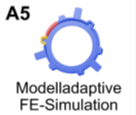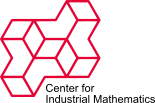Development of model adaptive simulation techniques for forming processes of complex functional components with complicated design details
| Working Group: | WG Modelling and Scientific Computing |
| Leadership: |
Prof. Dr. Andreas Rademacher ((0421) 218 63831, E-Mail: arademac@uni-bremen.de)
Heribert Blum |
| Processor: | |
| Funding: | Teilprojekt A5 im DFG-SFB/TR 73 Umformtechnische Herstellung von komplexen Funktionsbauteilen mit Nebenformelementen aus Feinblechen - Blechmassivumformung – |
| Project partner: | |
| Time period: | 01.01.2012 - 31.12.2016 |
 During the first period of this research project, basic techniques to realize model adaptive algorithms in the simulation of forming processes have been developed. Therefore, suitable model hierarchies were defined by using information and results from related subprojects, namely C1 – C4. As a criterion to switch between certain models, goal-oriented a posteriori error estimators for the modeling error based on the “dual-weighted-residual” (DWR) method were derived. Afterwards, these estimators were used in adaptive algorithms to decrease modeling and discretization error in a balanced manner. At last, first investigations concerning dimension adaptivity and transfer of developed tools into commercial finite-element software were carried out.
Main goal of the second period is further development and enhancement of the results derived from the first period. This especially contains derivation of a posteriori error estimators for coupled problems based on the DWR method. In this case, the modeling error, which arises from partly or even completely neglecting coupling, should be estimated and finally lead to an adaptive adjustment of coupling with regard to particular requirements. In the end, these techniques should be used in the algorithms for model and mesh adaptivity already developed in the first period.
The second part of this period deals with dimension adaptive algorithms. Therefor, coupling between solid-like-shell- and solid-elements must be realized. However, not only coupling of both element types but also conversion from one type to the other or vice versa must be dealt with. As characteristic for this subproject, the indicator whether to choose one or the other respectively convert from one to the other element formulation is to be set by goal-orientated a posteriori error estimators. The second step then is going to be the development of an algorithm which realizes on one hand the indication of elements and on the other hand the conversion of certain elements. Finally, an application to technological relevant models is preferable.
As an accompanying task during the whole second period, there is the transfer of developed tools to commercial software as well as the assignment to consider modeling approaches from related subprojects C1 – C4.
During the first period of this research project, basic techniques to realize model adaptive algorithms in the simulation of forming processes have been developed. Therefore, suitable model hierarchies were defined by using information and results from related subprojects, namely C1 – C4. As a criterion to switch between certain models, goal-oriented a posteriori error estimators for the modeling error based on the “dual-weighted-residual” (DWR) method were derived. Afterwards, these estimators were used in adaptive algorithms to decrease modeling and discretization error in a balanced manner. At last, first investigations concerning dimension adaptivity and transfer of developed tools into commercial finite-element software were carried out.
Main goal of the second period is further development and enhancement of the results derived from the first period. This especially contains derivation of a posteriori error estimators for coupled problems based on the DWR method. In this case, the modeling error, which arises from partly or even completely neglecting coupling, should be estimated and finally lead to an adaptive adjustment of coupling with regard to particular requirements. In the end, these techniques should be used in the algorithms for model and mesh adaptivity already developed in the first period.
The second part of this period deals with dimension adaptive algorithms. Therefor, coupling between solid-like-shell- and solid-elements must be realized. However, not only coupling of both element types but also conversion from one type to the other or vice versa must be dealt with. As characteristic for this subproject, the indicator whether to choose one or the other respectively convert from one to the other element formulation is to be set by goal-orientated a posteriori error estimators. The second step then is going to be the development of an algorithm which realizes on one hand the indication of elements and on the other hand the conversion of certain elements. Finally, an application to technological relevant models is preferable.
As an accompanying task during the whole second period, there is the transfer of developed tools to commercial software as well as the assignment to consider modeling approaches from related subprojects C1 – C4.

